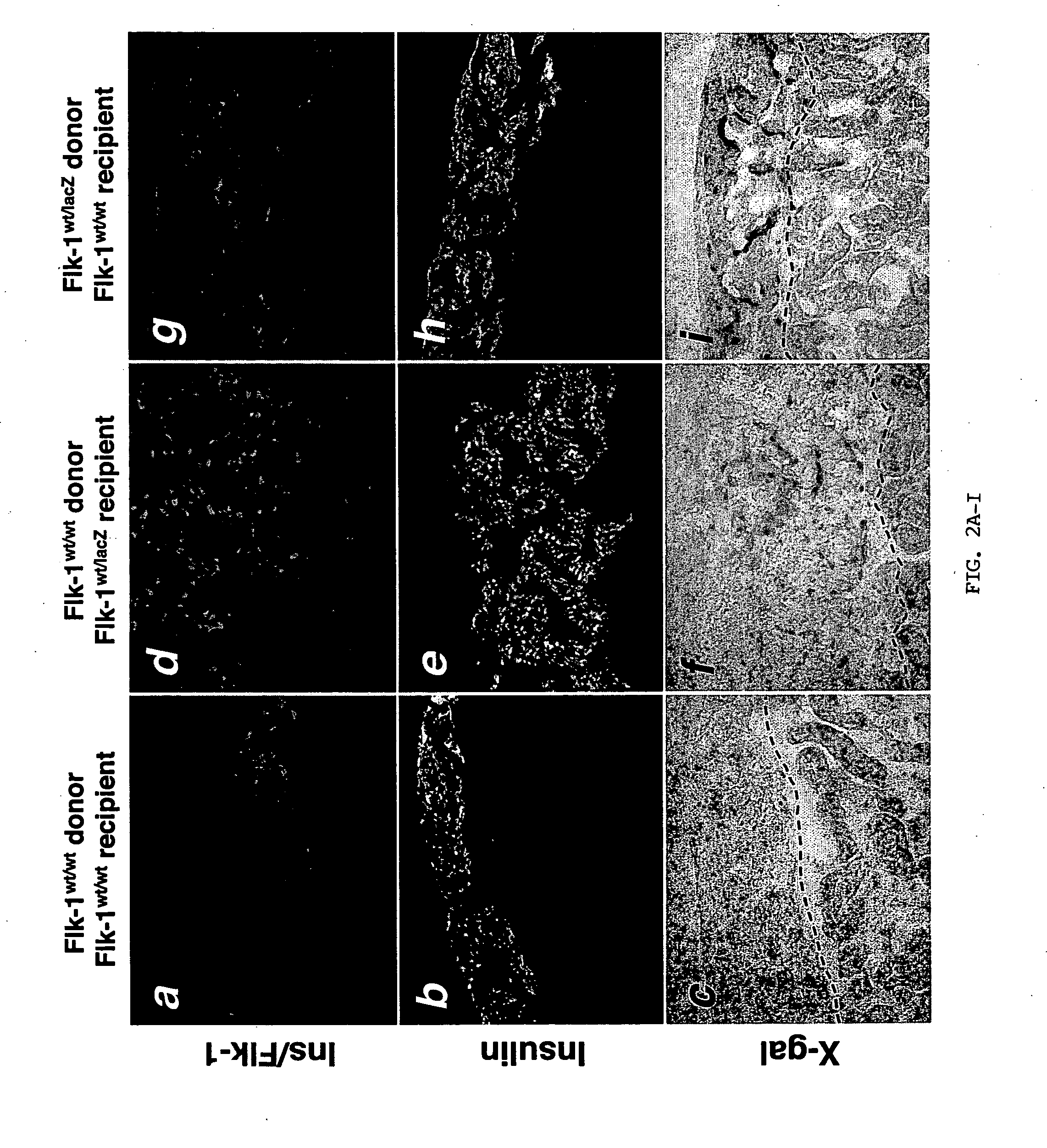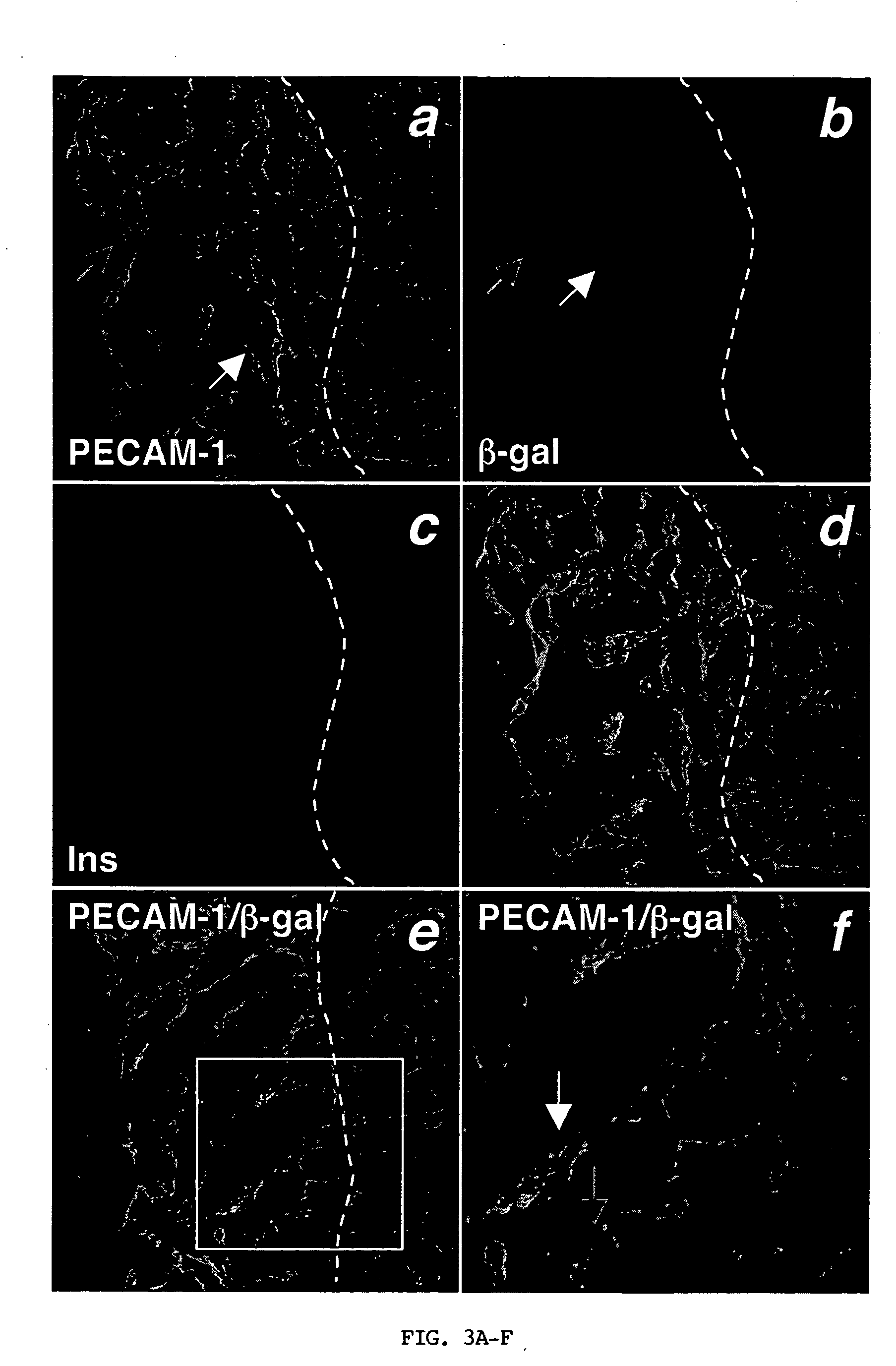Methods for improving pancreatic islet cell transplantation
a technology for pancreatic islets and transplantation, applied in the field of human cell biology and pathology, can solve the problems of attracting much interest, obtaining sufficient quantities of tissue, and a relatively low rate at which the transplanted islet survives and grafts successfully, so as to improve the revasculaturization and function of the transplanted islet, improve the quality and/or quantity of endothelial cells
- Summary
- Abstract
- Description
- Claims
- Application Information
AI Technical Summary
Benefits of technology
Problems solved by technology
Method used
Image
Examples
example 1
Materials and Methods
Animals. Flk-1 (KDR, VEGFR2) heterozygote mice with lacZ-tagged endothelial cells (Flk-1wt / lacZ) (Shalaby et al., 1995), C57BL / 6 mice, and NOD-SCID mice were obtained from the Jackson Laboratory (Bar Harbor, Me.). To identify the lacZ insert in the Flk-1 gene, the offspring of Flk-1wt / lacZ mice (stock number 002938; background strain C57BL / 6) were genotyped by PCR using the following primers to detect the LacZ insertion (5′ primer: ATC CTC TGC ATG GTC AGG TC; 3′ primer: CGT GGC CGT ATT CAT TTC) and the wild-type locus (5′ primer: CAA ATG TTG CTT GTC TGG TG; 3′ primer: GTC AGT CGA GTG CAC ATG TT). Transplants of mouse islets from Flk-1wt / lacZ donors and human islets were performed into immunodeficient NOD-SCID mouse model from Jackson Laboratory (for additional information, see jaxmicejax.org).
Mouse islet isolation. Islets were isolated from Flk-1wt / wt mice by dissection of splenic portion of the pancreas, followed by collagenase P digestion (Roche Molecular ...
example 2
Results
Expression of endothelial cell markers in isolated islets and pancreas of Flk-1wt / lacZ mice. Even though islet isolation severs arterial and venous connections, isolated islets retain their capillary network (FIG. 1A). Therefore, the inventors asked whether these intra-islet endothelial cells contribute to the revascularization of transplanted islets. To follow the fate of the intra-islet endothelial cells, a model in which endothelial cells are tagged with lacZ (knock-in of lacZ to the Flk-1 locus termed Flk-1wt / lacZ) was employed. LacZ encodes the β-galactosidase enzyme. FIG. 1B shows prominent X-gal staining (reflecting β-galactosidase activity) of islets in the whole-mount Flk-1wt / lacZ pancreas. Pancreatic sections in FIGS. 1C and 1D demonstrate that lacZ expression recapitulates expression of Flk-1. Similar to Flk-1 expression, there was a greater density of lacZ+ capillary structures in the islets compared to exocrine tissue reflecting the higher vascularity of islets...
PUM
| Property | Measurement | Unit |
|---|---|---|
| time | aaaaa | aaaaa |
| concentration | aaaaa | aaaaa |
| β-cell function | aaaaa | aaaaa |
Abstract
Description
Claims
Application Information
 Login to View More
Login to View More - R&D
- Intellectual Property
- Life Sciences
- Materials
- Tech Scout
- Unparalleled Data Quality
- Higher Quality Content
- 60% Fewer Hallucinations
Browse by: Latest US Patents, China's latest patents, Technical Efficacy Thesaurus, Application Domain, Technology Topic, Popular Technical Reports.
© 2025 PatSnap. All rights reserved.Legal|Privacy policy|Modern Slavery Act Transparency Statement|Sitemap|About US| Contact US: help@patsnap.com



